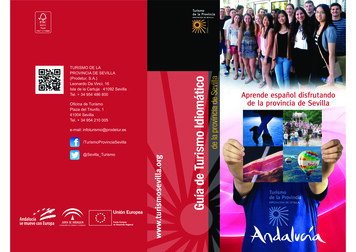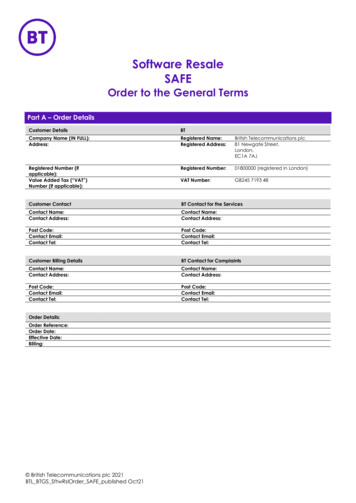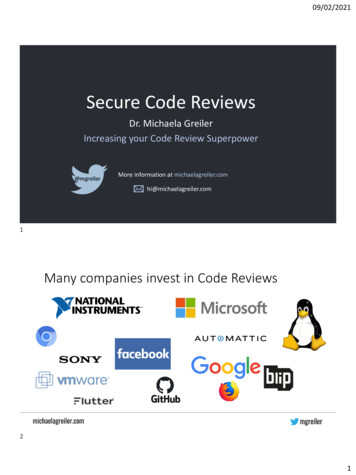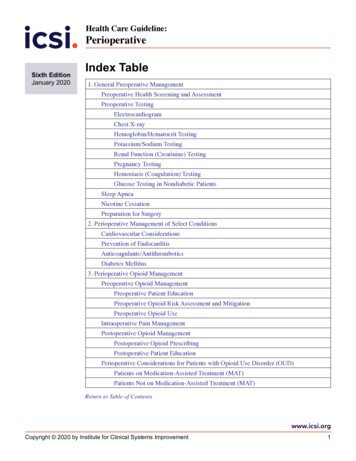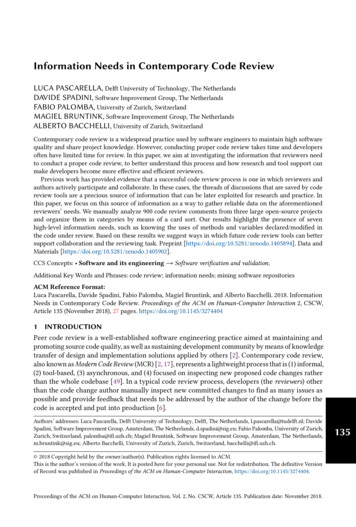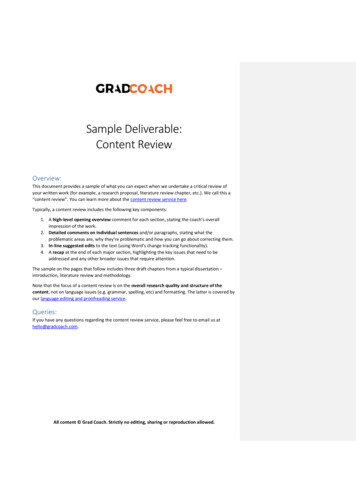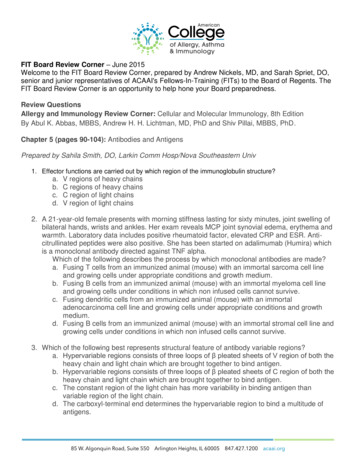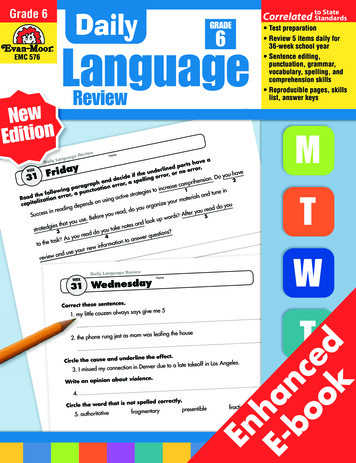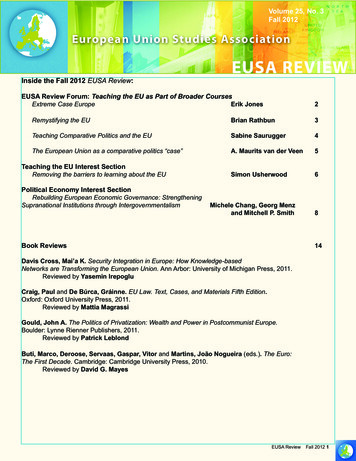
Transcription
Volume 25, No. 3Fall 2012Inside the Fall 2012 EUSA Review:EUSA Review Forum: Teaching the EU as Part of Broader CoursesExtreme Case EuropeErik Jones2Remystifying the EU Brian Rathbun3Teaching Comparative Politics and the EUSabine Saurugger4The European Union as a comparative politics “case”A. Maurits van der Veen5Teaching the EU Interest SectionRemoving the barriers to learning about the EU Simon Usherwood6Political Economy Interest SectionRebuilding European Economic Governance: StrengtheningSupranational Institutions through IntergovernmentalismMichele Chang, Georg Menzand Mitchell P. Smith8Book Reviews14Davis Cross, Mai’a K. Security Integration in Europe: How Knowledge-basedNetworks are Transforming the European Union. Ann Arbor: University of Michigan Press, 2011.Reviewed by Yasemin IrepogluCraig, Paul and De Búrca, Gráinne. EU Law. Text, Cases, and Materials Fifth Edition.Oxford: Oxford University Press, 2011.Reviewed by Mattia MagrassiGould, John A. The Politics of Privatization: Wealth and Power in Postcommunist Europe.Boulder: Lynne Rienner Publishers, 2011.Reviewed by Patrick LeblondButi, Marco, Deroose, Servaas, Gaspar, Vitor and Martins, João Nogueira (eds.). The Euro:The First Decade. Cambridge: Cambridge University Press, 2010.Reviewed by David G. MayesEUSA ReviewFall 2012 1
EUSA Review ForumTeaching the EU as Part of Broader CoursesThere have been other EUSA forums in the past onhow to organize courses about the EU. These coursesserve a useful purpose for students who want to learnspecifically what the EU is and how it works, but it is alsoimportant to teach the EU as part of broader courses.The experience of the European Union is relevant toour understanding of politics in general – otherwisewe would probably not be very interested in it. If thatis the case, then the EU can and should be integratedinto generalist courses of political science, especially inthe subfields of comparative politics and internationalrelations.That the EU should be taught as part of a bigger political science picture is easier said than done, however.The all-to-easy solution is to have a special class aboutthe EU as a separate “sui generis” case of internationalpolitics or comparative politics. We as teachers have allbeen tempted to do this and we have probably succumbed to the temptation at least once or twice. Butwe also know that it isn’t intellectually very satisfying.How can the EU be fitted into a regular politicalscience syllabus? Should the EU be taught as an actor, as a process, or as a “sui generis” phenomenon?What works with students, and what doesn’t? I haveasked these questions to two scholars of internationalrelations and two scholars of comparative politics.Since I wanted to also get a sense of what works withnon-European as well as European students, I decided,for each subfield, to pick one scholar based in Americaand one in Europe. The following pieces – by ErikJones, Brian Rathbun, Sabine Saurugger, and Mauritsvan der Veen – are these four scholars’ responses tothese questions.As the readers will realize, these responses are insome cases very personal, so their recipes will not workfor everybody. But I hope that they will provide food forthought on how to get our students excited about theEU, and to shake off the notion that European integration is just a boring technocratic exercise.Nicolas JabkoEUSA Review Editor2Fall 2012 EUSA ReviewExtreme Case EuropeErik JonesEuropean integration is globalization on steroids.That is what makes it fun to bring into the classroom,particularly in discussions of international politicaleconomy. If you want to know what kind of beyond-theborder measures it would take to level the playing fieldfor international trade and investment, just look at thecompletion of the internal market. If you are interestedin the choice between fixed and flexible exchange rates,the various stages of monetary integration will give youa sense of what is at stake. If you are worried aboutmacroeconomic imbalances, check out the sovereigndebt crisis in the eurozone. And if you want to engagein a thought experiment about a world where workerscan move freely across national boundaries, the historicenlargement of the European Union to the countries ofCentral and Eastern Europe and the travails of Europe’sSchengen area should feed your imagination.The extreme European cases are not only found inmacro-areas related to trade, capital movements, andmigration flows. They also arise in the policy process.Inter-governmentalism is ‘two-level games’. The German response to Europe’s sovereign debt crisis is agood illustration. In February 2009, a center-left German finance minister in a centrist grand coalition waswilling to pledge that no country that adopted the euroas its currency would ever go bankrupt. By the following November, a center-right Chancellor in an evenmore right-wing coalition was unwilling to reiterate thatcommitment. The German ‘national interest’ was thesame in both cases but the domestic bargain was fundamentally different. Chancellor Angela Merkel could notpledge to bail out insolvent eurozone countries withoutfracturing her coalition with the liberal Free DemocraticParty or jeopardizing her own Christian Democrats’performance in crucial regional elections. She choseto muddle through instead, much to the detriment ofGermany and Europe.In a similar vein, the European approach to technicalharmonization shows the power of norms over material self-interest. A good example here is the chocolate standard. Originally, the European Commissionproposed to set a threshold value for cocoa contentin any confections to be called ‘chocolate’. However,the British government objected. The UK’s largestconfectioner, Cadbury’s, makes sweets that are wellbelow any reasonable threshold and yet did not wantto market them as anything other than chocolate. Sothe Commission settled on a requirement to publish thecocoa content instead. Suddenly European consumerscould see just how much cocoa was in their chocolate.As the new standard propagated across the market, it
carried new norms for quality chocolate along with it –carrying both British consumers and Cadbury’s profitsalong with it.Most important, Europe shows how institutionsmatter both in the domestic determinants of Europeanpolitics and in the European determinants of domesticpolitics – Kenneth Waltz’s ‘second image’ and its reverse. The European Union is a common arena withinwhich very different countries interact and it is also acommon shock to which very different countries mustadapt. This is where it is possible to find the answers toquestions about why some countries, like Luxembourg,tend to have more influence that their relative size wouldsuggest, while others, like Italy, tend to have less. Thisis where the role European Union jurisprudence becomes important and where the implementation of EUlegislation matters as well. And it is the key to explainwhy some countries were affected more strongly bythe global economic and financial crisis while otherswere not – as well as why the effects across countriestended to vary so much over time.Finally, the European example is extreme becauseit is so unexpected. Most students come into the classroom with the presumption that Europe is old, tired, andperhaps even a little decadent (and not in a seductiveway). The reality is very different. Scratch the surfaceand you will find that Europe is riddled with crime,corruption, violence, and xenophobia – but it is also aplace of innovation, values, and cross-cultural dialog.European integration is an experiment for keeping thedarker side of Europe in check. If it looks boring on thesurface that is only because the experiment has beena success. Should it fail at some point in the future, wewill get to see another European extreme case.Erik JonesJohns Hopkins UniversityRemystifying the EUBrian RathbunWhen I was 19 years old, I went abroad for the firsttime - to Vienna, Austria for a semester-long programwith the wind ensemble from my college. We tookclasses and rehearsed during the week and playedconcerts around Central Europe on the weekends. Itwas there that I first fell in love.No, not with a little Austrian girl in Tracht a la Soundof Music. I developed my first intellectual crush, in theEuropean Community, about to become the EuropeanUnion. The member countries – well, most of them were about to embark on a revolutionary new projectin international integration, developing a common cur-rency. An Austrian politician – Andreas Kohl, who wouldlater shepherd historically neutral Austria into the EU –taught us about how it worked. At famous coffee housessuch as Café Museum, I read the English newspapersincluding the now defunct “European.” I followed the fateof the treaty in the British parliament, where it was ruthlessly denounced by the majority party despite the factthat John Major had secured opt-outs from all of its mostsensitive elements. That semester dictated the rest ofmy life. I became a political science major and wentto Berkeley to study with the great Ernst Haas. Eventhough the EU itself has never been directly the objectof my published work, its themes guide my researchstill today - peace through multilateralism, internationalcooperation and organizations, and diplomacy.When I teach about the European Union in myclass on international organizations I try to kindle thesame kind of student interest in this strange institution. But I can’t offer them good coffee. Everyone hasbeen crushed by Starbucks. And everything about myinstitution in California points west - towards Asia andthe future. All Europe is considered old here, not justthe Western part. So what do I do? I think the worstthing one can try is to treat the European Union as justanother international organization. Andy Moravcsik’sunfortunate influence on the field was, as a revieweronce wrote, to “demystify” the EU. Rather than the greathope for the future of liberal idealists, it is just a productof powerful interest groups in powerful countries makingcredible commitments to .zzzzzzzzzz.The first thing to do is to give students a sense ofjust how improbable the EU is considering the state ofEurope after World War II. It took a profound act of political courage to start the political process of Europeanintegration given the scale of the war and its destructiveness. The notion that this was just simple politicsas usual is so obviously wrong. It will also bore yourstudents to tears. It was an audacious idea, and one thathas never really been replicated anywhere else since.Students do not want to hear about how something wasdestined to happen. They want a story about a daringadventure in which an intrepid hero fought against allodds. This has the advantage of being true, except hewas not an action star but a technocrat whose namewas Jean Monnet.Second, and perhaps in contradiction, point outthe ridiculousness of the EU. The organization canbe, sometimes is, profoundly humorous. De Gaullewithdrew his representatives from Brussels during theEmpty Chair Crisis like a child who wouldn’t let anyoneplay with his toys. The alliance between the ChristianDemocrat Chancellor Kohl and Socialist PresidentMitterrand was terribly improbable, something broughthome by any image of the enormously rotund GermanEUSA ReviewFall 2012 3
holding hands (yes, holding hands!) with the diminutive Frenchman. You can find Thatcher’s “No! No! No!”speech on Youtube, where she diverts attention fromher own internal party dissension by redirecting angerat the Labour Party and the European CommissionerJacques Delors, all while being cat-called at Question Time in a way that is shocking and funny to anyAmerican. When you cover the creation of the commoncurrency and the ECB, you will have to deal with howthe credible commitment to low inflation is ensured bythe bank’s independence and how this was a necessityfor Germany to join. Just don’t put it that way. Insteadutilize the ECB’s own propaganda films for children. I amnot kidding. The EU produces short cartoons teachingthose in school about how the ECB protects them fromthe “inflation monster,” who is green and looks kind oflike the Tasmanian devil. And don’t even get me startedwith the banana regulations. If they are like my students,they will be mystified, which is just what we want.Brian RathbunUniversity of Southern CaliforniaTeaching Comparative Politics and the EUSabine SauruggerTeaching comparative politics in European universities has become an even more complex endeavourthat it was before the end of the cold war. Before thebeginning of the 1990s, teaching comparative politicsrequired an understanding of the structure and functioning of political systems of the biggest Europeanstates, and a number of smaller states – added for goodmeasure. Comparing states’ governmental institutions,judiciary, political parties, electoral systems, public policies and interest groups required a in-depth knowledgeof these issues but also a high degree of abstract thinking, which helped to create categories allowing to gobeyond simple case studies.Since the Single European Act, the MaastrichtTreaty and intensified globalisation processes, I teachcomparative politics with a sense of urgency. Not onlyis it necessary to constantly update our classes (addingthe names of new presidents, chancellors or prime ministers) as we did before. It has become crucial to takeinto account the continued impact European integrationand globalisation had on domestic political systems.Now, explaining to European comparative politicsstudents, generally rather fed up with the classes theyhad on the EU – as an institution, as a decision-makingsystem, as a historical entity – that they must listenand discuss issues linked to the European Union oftenleads to critical remarks. This is the case at least when4Fall 2012 EUSA Reviewthey are political science students in France, generallya rather critical bunch of young people. So I talk aboutthe political side of the EU’s influence on the domesticlevel. The debates on employment policies can’t be understood without taking into account EMU or the OpenMethod of Coordination. It is not possible to explaincomparative budgetary politics, domestic environmental or agricultural policies, or the comparative partymanifestos, without taking into account compliancepressures stemming from both EU hard law and softlaw: the Economic and Monetary Union, the CommonAgricultural Policy, the European Environmental Policy,or the rise of Euro-scepticism in divers forms across allpolitical parties.Once this is done, the real work begins. It is crucialin this context to forget about the “absolute beauty of theEU’s peace and love message of the 1950s and 1960s”.Nothing is worse in a comparative politics class than tohear about the great achievements and the inevitabilityof the European integration process. These achievements can be taken for granted. Today, it’s the conflicts,the debates, the banana wars and Euro-conflicts, theSanter resignation (albeit an old story) or the influenceof debates taking place in the European Parliament –real politics – on national debates that students cravefor – well, not really crave for, but are interested in. Inthis sense, the Europeanization literature has tremendously facilitated my teaching of comparative politics.There is, however also another way to look onteaching comparative politics: it then becomes a toolto study the European Union as such. In this ‘comparative politics of the EU’ class, I use methods developedin comparative politics to study the political system ofthe European Union – something that seems to havebecome somewhat of a consensus today. This helpsstudents understand the EU through comparisons withdomestic politics and links with broader debates inpolitical science. Again, this tremendously helps themnot to see the EU as some sui generis far-away thingin Brussels, but as a system that is all over the place.The problem for teaching the EU was for a long time itslove for technical jargon, even in political science – notto even mention law. The perceived end of the permissive consensus, and the subsequent politicisation of theEU (which does not end its jargon) have offered me thepossibilities to make students understand that the EUis a process, and not only a ‘thing’ largely disconnectedfrom real politics.Sabine SauruggerSciences Po-Grenoble
The European Union as a ComparativePolitics “case”A. Maurits van der Veennot reside at the same level. The EU’s struggles withlegitimacy and its perceived democratic deficit similarlyoffer great material for the investigation of these topics.Where and how does the European Union fit intocomparative politics? For many American students,unfortunately, the EU is simply synonymous with theeurozone. In light both of the real-world prominenceof the European Union in politics, and of its theoreticalinterest as a sui generis experiment in something akinto state-building, this state of knowledge deserves tobe remedied in broad comparative politics courses, notjust in courses specifically focused on the EU. Probablythe most common approach is simply to add a unit onEuropean integration towards the end of the course.I want to argue here that doing so misses a valuableopportunity for promoting student understanding ofcomparative politics in general.In fact, the European Union is an excellent “case” toillustrate a host of different topics, for two reasons. First,although it is not a state, it does many things states do,and thus represents an outlier in comparison to which“normal” states can be better understood. Second,unlike in most states, almost everything the EuropeanUnion does is the result of explicit, and often strategic,decision-making on the part of its member states.Moreover, we often have at our disposal records of andinformation about these decisions. In many states, incontrast, historical accident or political forces long-sincespent account for institutional and legal outcomes visible today.Consider, by way of example, the issue of electoralsystems. Elections to the European Parliament are byproportional representation. This is no historical accident: it was extensively debated, and we have recordsof the arguments made on all sides. Moreover, differentcountries have chosen different versions of proportionalrepresentation. In addition, several countries — mostprominently the United Kingdom — use an electoralsystem for EP elections that is different from that fornational elections. In other words, all the key considerations and implications associated with electoralstructures can be covered simply by studying the various EU-level and national decisions on the issue.Nor are electoral systems the only issue where theEU is a valuable case. For any discussion of the natureand implications of national identity, the EU’s strugglesto develop something akin to an “EU identity” serve tohighlight many of the key puzzles associated with identity. In studying the state’s role in fostering economicdevelopment, the EU’s experience with regional andcohesion policy can illustrate key challenges. On issues of governance, the EU represents an interestingcase of multi-level governance, demonstrating, amongothers, that legislative and implementing powers needWith this approach, students will not need to read muchEU-specific literature; instead, the EU can simply beused as an in-class example to illustrate issues raisedin concept- or issue-focused readings. Of course, someminimal background information about the EU will be important if the EU case is to make any sense to students.Fortunately, this is easily addressed by asking them toread one of several simple introductions that exist. TheEU itself offers “Europe in ten points” (http://ec.europa.eu/publications/booklets/eu glance/12/txt en.htm, byPascal Fontaine); the first point, a brief history, is really all that is needed to get started. (I prefer this to theEU’s “guide for Americans,” de-for-Americans.html.) Oncearmed with the basics, students should be equipped toconsider the EU as an unusual but nevertheless illuminating case in studying a host of issues.A. Maurits van der VeenCollege of William & MaryThe EUSA Executive Committee ispleased to announce the online publication of the first EUSA Biennial ConferenceSpecial Issue of the Journal of EuropeanPublic Policy (JEPP). This Special Issue includes seven (revised) papers selected by peer review from amongst thosenominated by discussants and chairs asamong the best presented at 2011 Biennial EUSA conference. The Special Issuecan be found at http://www.tandfonline.com. The paper version is now available.We look forward to continuing this collaboration between JEPP and EUSA in the future and expect that 6-8 papers from the2013 EUSA Conference, May 9-11, 2013,to be held in the Baltimore/Washington DCmetro area, will again be selected for publication in a future special JEPP/EUSA issue.EUSA ReviewFall 2012 5
Teaching the EUInterest SectionRemoving the Barriers to Learning about the EUSimon UsherwoodOne of the most frequent refrains that I hear fromcolleagues teaching on the European Union is that‘students find it difficult.’ Indeed, it appears to be notonly difficult for students, but also for teaching staff: tolook at much at what has been written on Learning &Teaching (L&T) on the EU, there is a surfeit of discussion about ‘complexity’, ‘intricacies’ and ‘barriers tolearning’. Even when teaching staff are positive aboutthe subject, students (especially in the UK) can oftenbe suspicious that there is a normative agenda at work,to make them love the Union!This is neither healthy nor sustainable. Studentsmight approach the subject with trepidation (if we’relucky) or apathy (if we’re not), but too often we arecomplicit in providing an excuse for not engaging or notunderstanding. The EU joins other ‘difficult’ subjects –research methods springs to mind – in a dusty cornerof L&T, to be taught as a necessity, with no great delighton either side of the classroom.This has to change: the EU is a fundamental partof contemporary European (and global) politics andto ignore it will only perpetuate the problems of lowunderstanding that we find in the general population.Three key ways of addressing this challenge presentthemselves.Firstly, we need to understand our students’ attitudes and dispositions much better. Whether throughquantitative questionnaires or more qualitative interviews, we have to build up a clearer picture of students’prior knowledge, their interests within ‘the EU’, as wellas their prior concerns about building their understanding. This might be about basic concepts of supranationalism versus intergovernmentalism, or about morepractical aspects of what each institution is called (theall-too-familiar ‘European Council/Council of Europe’problem).As social scientists we would expect ourselves toground any research project in the data we have, andthis is no different: regardless of our theoretical approach to the Union, we still have to bring that into thespecific environment of the classroom and make it workfor our students, ipso facto we need to understand ourstudents.Secondly, we have to change our attitude as teachers. The EU might not be a simple political organisation, but it is no more complex than a typical state: that6Fall 2012 EUSA Reviewteaching of the former usually tries to cover everything,while teaching of the latter often focuses on particularparts (legislatures, executives, etc.) might obscure this.This requires stress on the simplicity of underlying concepts: two-level games or principal-agent relationshipsare just two examples that spring to mind.Importantly, it is not about ‘selling’ the integrationprocess in normative terms: understanding is not thesame as approbation. Certainly, enthusiasm for one’ssubject is a great bonus for a teacher, but just as webring different theoretical and analytical tools to bearon our research of the EU, so too can we bring differentattitudes. Indeed, if we are to build student engagement, then we have to be able to accommodate differentpositions if we are not risk shutting down debate.Consequently, in my classes on European integration, I spend a significant block of time talking aboutcore concepts in more abstract terms, before applying them back into the context of the EU. Colleagueselsewhere have made conscious efforts to discuss theUnion through the use of metaphors and analogies. Mypersonal favourite comes from the team at the CatholicUniversity of Paris, where they describe the Union as astudent house, with bedrooms that are private to eachstudent, but with communal areas (kitchen, bathroom,etc.) that require joint management. Such intuitivelysimple models act as heuristics to learning as much asanything else, opening up debate, rather than closingit down.Thirdly, and rather less obviously, we might talk lessabout the European Union, in the sense of it being theobject of our study. Instead, we might profit from talkingabout other subjects, illustrated through the exampleof Union. At a recent conference, one colleague discussed how her own realisation that the EU was a siteof politics enabled her to completely and fundamentallyreconceptualise her approach to the subject.This is an area where non-traditional pedagogieshave a clear role to play. Many colleagues already usesimulation games to explore case studies within the EU,but they can also be used as starting points for students’understanding of negotiating dynamics and institutionalconstraints. Moreover, simulations develop students’skills in research, presentation, working with other andnegotiation as well as enhancing their conceptualisations of more generic questions of politics, such aspower, compromise and consensus. Likewise, problembased learning techniques can offer a very powerful wayinto complex questions and issues, placing the studentfront and centre in that process: Maastricht Universityis an excellent example of how this approach can beused across an entire course of study, asking criticalquestions and supporting students in their discovery ofanswers.
Such techniques are labour-intensive, but they offerspace to both teachers and students to escape fromthe shackles of ‘difficulty’, by opening up new ways toconceptualise and debate the subject material. Moreparticularly, they instrumentalise knowledge and learning, giving it a clear and immediate purpose: certainly,I have yet to encounter a student who has not founda simulation to be of some interest and use for themselves.Ultimately, by taking these steps and challengingour (and students’) preconceptions about the EuropeanUnion we can move out of this attitudinal problem, to thepoint where we can start to simply concentrate on thekey questions about the integration process that interest us, rather than how we go about discussing them.Indeed, even if that goal isn’t achieved immediately,then we should still take succour from the simple factof trying. Compared to many other areas of social sciences, European studies has been relatively proactivein engaging with non-traditional pedagogies: I wouldventure to say that we all know someone who has gonebeyond the lecture/seminar model in their teaching ofthe EU. Even if these various efforts don’t always work,the mere fact of trying has made EU studies somethingof a hotbed of experimentation. Thus we might do wellto take that out to our colleagues in other subjects, toshow them the potential of challenging conventionalthinking.While we cannot change the fortunes of the European Union itself, we can change how we try to engagewith it as teachers. In so doing, we can help studentsto get beyond their preconceptions – both of the subjectand of the way it’s taught – we can make for a learningenvironment that interests and stimulates us, and wecan offer something to the wider community by way ofpedagogic practice. The path is already sketched out:it just remains for us to take it.Simon UsherwoodUniversity of SurreyEUSA ReviewThe EUSA Review (ISSN 1535-7031) [formerly the ECSA Review] is published three times yearly by the European UnionStudies Association, a membership association and non-profitorganization (founded in 1988 as the European CommunityStudies Association) devoted to the exchange of informationand ideas on the European Union. We welcome the submissionof scholarly manuscripts. Subscription to the EUSA Review is abenefit of Association membership.Editor:Nicolas JabkoBook Reviews Editor:Susanne SchmidtManaging Editor:Joseph Figliulo2011-2013 EUSA Executive CommitteeAmie Kreppel, Chair(University of Florida)Michelle Egan, Vice Chair(American University)Adrienne Héritier(European University Institute)Nicolas Jabko(Johns Hopkins University)Berthold Rittberger(University of Mannheim)Susanne K. Schmidt(University of Bremen)Mitchell Smith(University of Oklahoma)Alberta Sbragia, ex officio member(University of Pittsburgh)Immediate Past Chair (2009-2011)Adrienne Héritier(European University Institute)European Union Studies Association415 Bellefield HallUniversity of PittsburghPittsburgh, PA 15260 USAWeb www.eustudies.orgE-mail eusa@pitt.eduEUSA ReviewFall 2012 7
Political Economy Interest Section ReRebuilding European Economic Governance:Strengthening Supranational Institutions throughIntergovernmentalismMichele Chang, Georg Menz and Mitchell P. SmithAs the sovereign debt crisis rages on, the Eurozone has been struggling to shore up market confidence in the short-run and lay a stronger foundation forthe currency area in the long-run by reforming Europeaneconomic governance. The monetary arm of Economicand Monetary Union has been strengthened throughthe expansion of the European Central Bank’s powersinto a de facto lender of last resort and the creation ofa crisis fund, the European Stability Mechanism. Fiscal,financial and economic p
EUSA Review Fall 2012 1 Inside the Fall 2012 EUSA Review: EUSA Review Forum: Teaching the EU as Part of Broader Courses Extreme Case Europe Erik Jones 2 Remystifying the EU 3 Brian Rathbun Teaching Comparative Politics and the EU Sabine Saurugger 4 The European Union as a comparative politics "case" A. Maurits van der Veen 5
